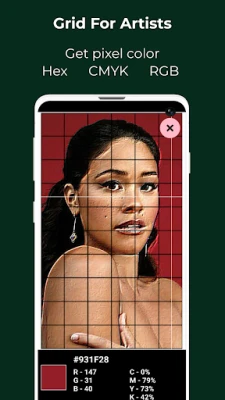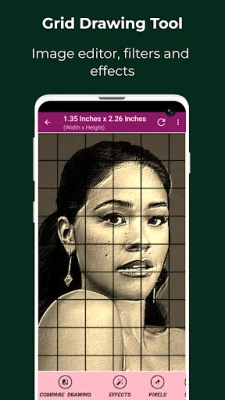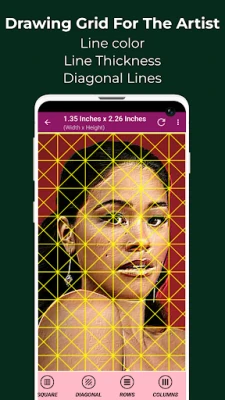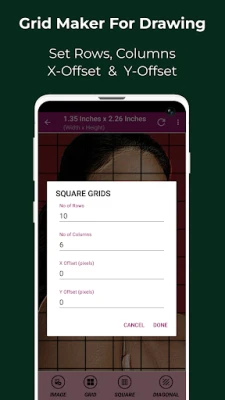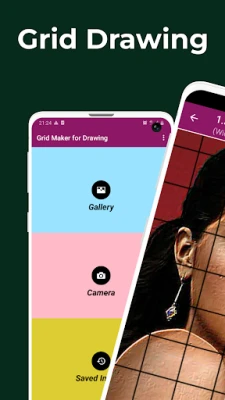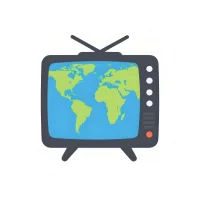
Latest Version
Version
5
5
Update
June 28, 2025
June 28, 2025
Developer
The AppGuru
The AppGuru
Categories
Tools
Tools
Platforms
Android
Android
Downloads
0
0
License
Free
Free
Package Name
grant.grid.maker.drawing
grant.grid.maker.drawing
Report
Report a Problem
Report a Problem
More About Grid Drawing APK Download for android
Grid Drawing is an art and illustration technique that involves Drawing a Grid over your Reference Photo and then creating a Grid of the same ratio on your work surface like wood, paper or canvas. The artist then draws the image on the work surface, focusing on one square at a time, until the entire image has been transferred or reproduced.
Getting Into Grid Drawing: Why It’s Not Just for Beginners
Okay, so grid drawing. If you’ve ever picked up a pencil and tried to copy something complicated—like a portrait or a detailed building—you probably hit a wall. That’s where grid drawing comes in. It’s like a cheat code, but not really cheating. More like a smart shortcut.
What’s Grid Drawing Anyway?
At its simplest, grid drawing is about breaking down a big, complicated image into smaller squares. You draw a grid on your reference picture and then copy that same grid onto your paper or canvas. Then, instead of trying to tackle the whole thing at once, you focus on one square at a time.
Sounds kind of tedious? Maybe. But also kind of genius. Because suddenly, you’re not overwhelmed by the whole image, just a tiny piece of it. You’re basically zooming in and taking bites instead of swallowing the whole thing raw.
Why People Use Grid Drawing
A lot of artists, especially those just starting, use grid drawing to get their proportions right. It’s a great tool to help your eye learn how to see shapes and spaces correctly.
The thing about grid drawing is, it teaches patience. And attention to detail. If you rush, you’ll mess it up. But if you slow down, square by square, you’ll see improvement.
I’ve noticed that people search for terms like “drawing techniques for beginners,” “how to improve sketching accuracy,” and “drawing grids for portraits”—all tied to this method. So yeah, it’s kind of a go-to for those wanting to level up without getting frustrated.
What You Need to Get Started
You don’t need a fancy studio or expensive gear. Honestly, just a ruler, pencil, eraser, and some paper will do. For the grid on the reference image, some folks use software these days. Others just eyeball it or print out graph paper and slap it over.
You can also use grid drawing for all sorts of art styles—realism, cartoons, landscapes, whatever. It’s flexible. The key is to keep your grid squares proportional on both the reference and your drawing surface.
The Not-So-Perfect Side of It
Here’s the thing: grid drawing isn’t magic. You still have to practice. Sometimes it feels slow, even boring. So it helps to keep stepping back and looking at your work as a whole now and then.
Why It’s Worth It Anyway
When you nail grid drawing, it’s satisfying. Like when you finally see that your sketch looks exactly like the photo.
A Few Tips If You’re Trying It Out
Don’t stress about making perfect squares. Rough is okay, as long as it helps you divide the image evenly.
Use light lines for your grid so you can erase or cover them later without fuss.
Work on one square at a time, but glance at the whole image often.
Try different grid sizes. Bigger squares mean less detail, smaller squares mean more precision but more work.
Remember, the goal is to train your eye, not just copy mechanically.
Okay, so grid drawing. If you’ve ever picked up a pencil and tried to copy something complicated—like a portrait or a detailed building—you probably hit a wall. That’s where grid drawing comes in. It’s like a cheat code, but not really cheating. More like a smart shortcut.
What’s Grid Drawing Anyway?
At its simplest, grid drawing is about breaking down a big, complicated image into smaller squares. You draw a grid on your reference picture and then copy that same grid onto your paper or canvas. Then, instead of trying to tackle the whole thing at once, you focus on one square at a time.
Sounds kind of tedious? Maybe. But also kind of genius. Because suddenly, you’re not overwhelmed by the whole image, just a tiny piece of it. You’re basically zooming in and taking bites instead of swallowing the whole thing raw.
Why People Use Grid Drawing
A lot of artists, especially those just starting, use grid drawing to get their proportions right. It’s a great tool to help your eye learn how to see shapes and spaces correctly.
The thing about grid drawing is, it teaches patience. And attention to detail. If you rush, you’ll mess it up. But if you slow down, square by square, you’ll see improvement.
I’ve noticed that people search for terms like “drawing techniques for beginners,” “how to improve sketching accuracy,” and “drawing grids for portraits”—all tied to this method. So yeah, it’s kind of a go-to for those wanting to level up without getting frustrated.
What You Need to Get Started
You don’t need a fancy studio or expensive gear. Honestly, just a ruler, pencil, eraser, and some paper will do. For the grid on the reference image, some folks use software these days. Others just eyeball it or print out graph paper and slap it over.
You can also use grid drawing for all sorts of art styles—realism, cartoons, landscapes, whatever. It’s flexible. The key is to keep your grid squares proportional on both the reference and your drawing surface.
The Not-So-Perfect Side of It
Here’s the thing: grid drawing isn’t magic. You still have to practice. Sometimes it feels slow, even boring. So it helps to keep stepping back and looking at your work as a whole now and then.
Why It’s Worth It Anyway
When you nail grid drawing, it’s satisfying. Like when you finally see that your sketch looks exactly like the photo.
A Few Tips If You’re Trying It Out
Don’t stress about making perfect squares. Rough is okay, as long as it helps you divide the image evenly.
Use light lines for your grid so you can erase or cover them later without fuss.
Work on one square at a time, but glance at the whole image often.
Try different grid sizes. Bigger squares mean less detail, smaller squares mean more precision but more work.
Remember, the goal is to train your eye, not just copy mechanically.
Rate the App
Add Comment & Review
User Reviews
Based on 0 reviews
No reviews added yet.
Comments will not be approved to be posted if they are SPAM, abusive, off-topic, use profanity, contain a personal attack, or promote hate of any kind.
More »










Popular Apps

MessengerMeta Platforms, Inc.
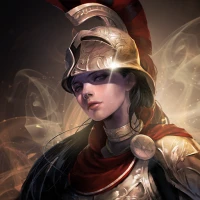
Road to Valor: EmpiresDreamotion Inc.

WhatsApp MessengerWhatsApp LLC

Call of Duty Mobile Season 8Activision Publishing, Inc.

Video downloader - Story SaverETM Video Downloader

WhatsApp MessengerWhatsApp LLC

PUBG MOBILELevel Infinite

Conflict of Nations: WW3 GameDorado Games / DOG Productions Ltd

AoD Vikings: Valhalla GameRoboBot Studio
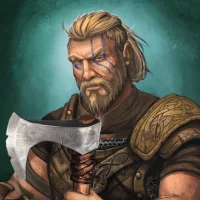
Viking Clan: RagnarokKano Games
More »










Editor's Choice

Moj BH Telecom APK Download for androidBH Telecom d.d. Sarajevo

WhatsApp MessengerWhatsApp LLC

Grim Soul: Dark Survival RPGBrickworks Games Ltd

Craft of Survival - Gladiators101XP LIMITED

Last Shelter: SurvivalLong Tech Network Limited

Dawn of Zombies: Survival GameRoyal Ark
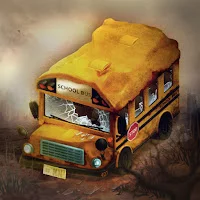
Merge Survival : WastelandStickyHands Inc.

AoD Vikings: Valhalla GameRoboBot Studio

Viking Clan: RagnarokKano Games

Vikings: War of ClansPlarium LLC

